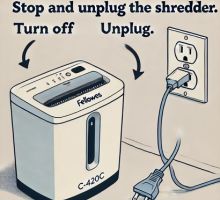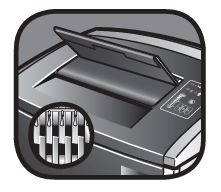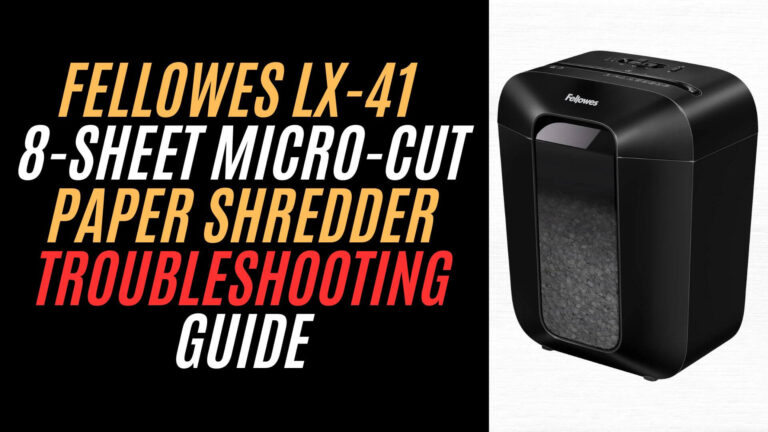The auto-start/stop feature in the Fellowes C-420C shredder simplifies shredding by automatically activating the motor when paper is detected and stopping when shredding is complete. However, malfunctions in this system, such as the shredder failing to start or stopping unexpectedly, can disrupt productivity. These issues are often caused by sensor obstructions, dust accumulation, or software glitches.
This guide will help you troubleshoot and resolve auto-start/stop malfunctions with simple, actionable steps.

Why Fixing Auto-Start/Stop Malfunctions is Important

Addressing auto-start/stop issues promptly ensures that your shredder functions efficiently. Here’s why resolving these problems is essential:
- Prevents Operational Downtime: A malfunctioning shredder can halt workflow, especially in busy office environments.
- Prolongs Shredder Lifespan: Ignoring sensor or software issues can lead to further wear and tear, reducing the machine’s longevity.
- Enhances Safety: Ensuring proper operation reduces the risk of accidents caused by unexpected starts or stops.
Common Causes of Auto Start/Stop Malfunctions
The auto-start/stop function in the Fellowes C-420C shredder is designed for convenience and efficiency, but it can occasionally malfunction due to various reasons. Here’s an expanded overview of the most common causes:
1. Sensor Obstructions

Dust, debris, or paper fragments can block the sensors, preventing them from accurately detecting paper.
Blocked sensors disrupt the auto-start function, causing the shredder to remain idle even when paper is inserted.
How to Prevent It:
- Clean the sensor area regularly with a soft cloth or compressed air.
- Avoid shredding materials like sticky notes or adhesive labels that can leave residue on the sensors.
2. Environmental Interference
Bright light, reflective surfaces, or excessive vibrations can interfere with the sensors, leading to false activations or failures.
External interference reduces the reliability of the auto-start/stop feature, making the shredder less responsive.
How to Prevent It:
- Place the shredder in a stable, well-lit, and dust-free location, away from windows or mirrors.
- Ensure the surface it rests on is even and does not vibrate during use.
3. Dust Accumulation
Over time, fine paper dust can accumulate on the sensors and around the internal components, causing them to malfunction.
Dust affects the sensitivity of the sensors, leading to irregular auto-start or delayed stop functionality.
How to Prevent It:
- Perform a deep clean of the shredder every month using compressed air and a vacuum cleaner to remove internal dust.
4. Software Glitches
Internal control system errors may result in inconsistent auto-start/stop performance.
Software glitches disrupt normal operation and may require a manual reset to restore functionality.
How to Prevent It:
- Regularly reset the shredder as per the manual’s guidelines to clear minor software errors.
5. Misaligned Sensors
The sensors may shift out of position due to vibrations or improper handling.
Misaligned sensors fail to detect paper correctly, causing malfunctions in auto-start/stop.
How to Prevent It:
- Periodically inspect the sensors for proper alignment and adjust them as necessary.
Step-by-Step Guide to Fixing Auto Start/Stop Malfunctions
When the auto-start/stop function in your Fellowes C-420C shredder malfunctions, follow this detailed step-by-step guide to diagnose and fix the issue.
Step 1: Turn Off and Unplug the Shredder

- Disconnecting the shredder ensures safety during troubleshooting and resets the internal control system.
- Switch the shredder off and unplug it from the power outlet. Wait for a few minutes to allow the system to reset.
Step 2: Inspect and Clean the Sensors

- Cleaning removes dust and debris that might be obstructing the sensors.
- How to Do It:
- Open the paper entry slot to locate the sensors near the feed area.
- Use a cotton swab dipped in rubbing alcohol to gently clean the sensors.
- Blow compressed air into the slot to clear any lingering dust particles.
Step 3: Check for Paper Fragments
- Tiny paper pieces lodged near the sensors can block their view and disrupt detection.
- How to Do It:
- Inspect the feed area for any paper fragments.
- Use tweezers to carefully remove any visible pieces.
Step 4: Reset the Shredder
- A reset clears minor software errors and recalibrates the sensors.
- How to Do It:
- Plug the shredder back in and locate the reset button (refer to the manual for its exact location).
- Press and hold the reset button for 5-10 seconds to initiate recalibration.
Step 5: Test the Auto-Start/Stop Function
- Testing ensures that the issue has been resolved.
- How to Do It:
- Insert a single sheet of paper into the shredder.
- Observe whether the shredder starts and stops automatically.
- Repeat the test with multiple sheets to confirm consistent operation.
Step 6: Reposition the Shredder
- Bright light or reflective surfaces can interfere with sensor functionality.
- How to Do It:
- Move the shredder to a location away from direct sunlight or mirrors.
- Place it on a stable surface to reduce vibrations during use.
Step 7: Call for Professional Assistance (If Needed)
- Persistent issues may indicate deeper mechanical or software problems.
- How to Do It:
- Contact Fellowes customer support or a certified technician for an inspection and repair.
Preventive Maintenance Tips for Auto Start/Stop Features
Preventive maintenance ensures that the auto-start/stop function in your Fellowes C-420C shredder operates smoothly and reduces the likelihood of malfunctions. Here are expanded tips:
1. Clean Sensors Regularly
- Dust and paper fragments can obstruct sensors, leading to detection issues.
- Use a cotton swab dipped in rubbing alcohol to clean the sensors every two weeks or after heavy use. Blow compressed air into the paper entry slot to remove fine dust particles.
2. Keep the Shredder Environment Dust-Free
- External dust can settle on the shredder components, reducing efficiency over time.
- Place the shredder in a clean, low-dust area, and wipe the exterior regularly with a lint-free cloth.
3. Shred Approved Materials Only
- Shredding adhesive labels, laminated materials, or other non-paper items can leave residue on sensors and gears.
- Follow the manufacturer’s guidelines to shred only approved materials, such as clean, dry paper.
4. Inspect and Align Sensors
- Misaligned sensors may fail to detect paper or cause false activations.
- Periodically check sensor alignment and realign as needed. Refer to the manual for proper positioning.
5. Perform Regular Resets
- Resetting the shredder clears minor software errors that can affect the auto-start/stop functionality.
- Press and hold the reset button for 5-10 seconds monthly or after cleaning the sensors.
6. Lubricate Blades Frequently

- Properly lubricated blades reduce motor strain, indirectly supporting sensor functionality.
- Apply Fellowes-approved shredder oil after every 500 sheets or bin emptying to maintain smooth operation.
Frequently Asked Questions (FAQs)
How often should I clean the sensors on my shredder?
Clean the sensors every two weeks or whenever you notice irregularities in the auto-start/stop function. For heavy usage environments, consider cleaning more frequently.
Why does my shredder fail to start automatically?
This could be due to dust or debris blocking the sensors. Ensure the sensors are clean and the shredder is placed in a well-lit, dust-free environment.
How do I reset my Fellowes C-420C shredder?
To reset, turn off the shredder, unplug it, and wait a few minutes. Plug it back in, then press and hold the reset button for 5-10 seconds.
Can external light or reflections affect sensor performance?
Yes, bright light or reflective surfaces can interfere with sensor detection. Relocate the shredder to a less exposed area if this occurs.
What should I do if the shredder keeps running without stopping?
Clean the sensors and check for lodged paper fragments. If the issue persists, reset the shredder to recalibrate the auto-start/stop function.
Why does the shredder stop mid-operation?
This may be due to dust accumulation on the sensors or insufficient power supply. Ensure the shredder is plugged securely and the sensors are clean.
Can I disable the auto-start/stop feature?
While it’s not recommended to disable this feature, some models allow temporary overrides. Refer to the manual for specific instructions.
Conclusion
Fixing auto-start/stop malfunctions in your Fellowes C-420C shredder is straightforward with regular cleaning, recalibration, and proper maintenance. By addressing sensor obstructions, managing environmental factors, and following the steps in this guide, you can ensure your shredder operates smoothly and efficiently.
Regular preventive care will keep auto-start/stop features working flawlessly, saving time and avoiding frustration.



